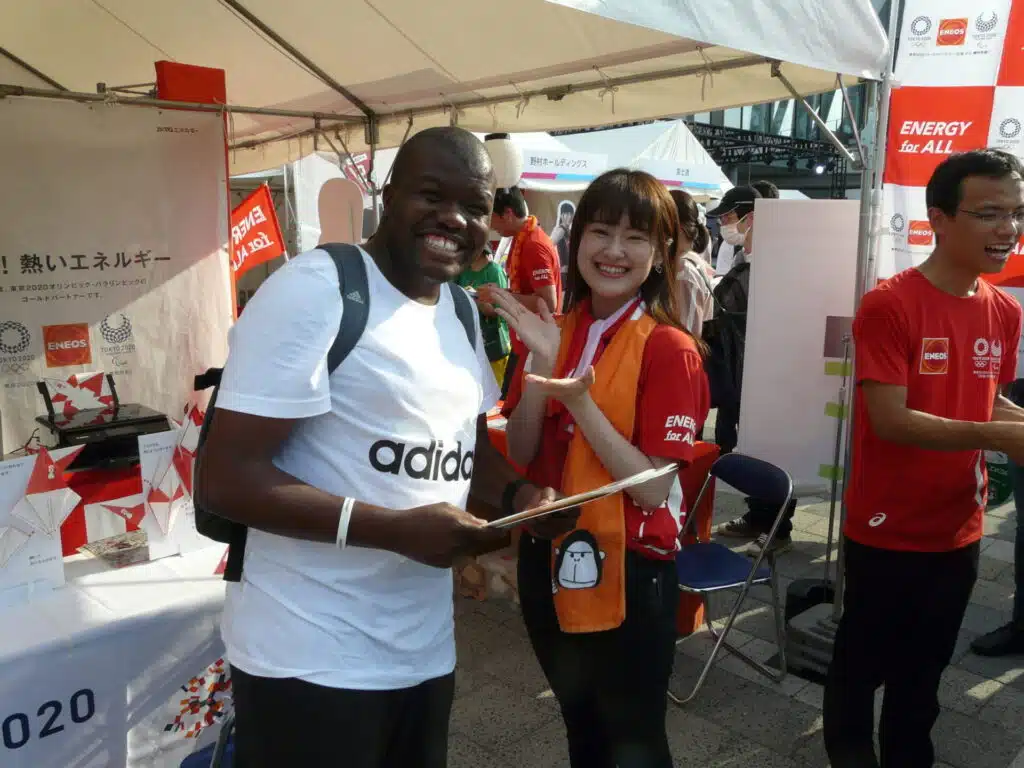How to Apply for the JET Programme in Japan (2025 Guide + Insider Tips)
Table of Contents
- Introduction
- Why choose JET?
- Who should apply?
- Step-by-step process
- Final thoughts
Japan – a one-of-a-kind country which is having a TEFL moment right now.
Picture this: grabbing ramen after work in Tokyo, cycling past temples in Kyoto, or joining festivals in a small countryside town. Lowkey your vibe?
The JET Programme is your ticket to living and teaching in Japan — but here’s the catch: thousands apply every year, and only some make it through. Don’t stress, though — we’ve got you.
In this post, we’ll walk you through the steps to apply to the JET Programme – with a little help from a friend, too. You’ll get the inside scoop from a current JET teacher, Sithembiso, who is currently [in 2025] in his third year with the JET Programme. He’ll give us his practical tips to help stand out in your JET application.
If you want to find out more details about the JET Programme first, take a minute and read our guide: 11 Things You Need To Know About The JET Programme.

Why choose the JET programme?
There are so many different programmes out there available to TEFL teachers in a foreign country, why should you choose the JET Programme?
- Competitive salary and benefits: The JET Programme offers one of the best pay-and-perk packages in Asia for entry-level TEFL teachers.
- Cultural immersion with strong support: JET provides a structured support system both in and outside the classroom. It’s a great starting point for new teachers.
- Career and networking opportunities: The programme has a strong international reputation and alumni network, which can open doors for future teaching positions, careers in education, international relations, or even government roles.
Who should consider the JET programme? The JET programme is suitable for recent graduates from university, or for those looking for a career change in their early or late thirties.
Convinced? Let’s get down to the application.
Who should apply?
We’re not going to beat around the bush here. Even the JET Programme website admits that “Applying to participate in the JET Programme is a long and competitive process”.
But there’s no need to cry into your Buldak Ramen. Sit back, relax and check out our step-by-step guide to the JET application process. We’ve got you, fam.
Step-by-step application process

The application process opens from mid-September for the JET programme for intake for the following year. But the specific application closing dates vary depending on your country of citizenship.
For example, in 2025:
- South Africans can apply until 17 October.
- US citizens can apply until 14 November.
- UK citizens can apply until 6 November.
Candidates need to apply at the Embassy of Japan in their home country. This can be done through the embassy website or the JET Programme website, depending on your nationality. These websites have all the information you need for your application, as well as tips, advice and resources.
The application process is rigorous and takes up to 6 months to complete, if you are a successful applicant.
You can find your relevant website here:
Now let’s get down to the specific steps of your application.
Prepare your documents
- Download the application form instructions. These are very important. Read them carefully and make sure you follow them to the letter. Instructions differ from country to country.
- Download the application form. Fill it in digitally (preferred) or print and fill it in neatly.
- Prepare a Statement of Purpose (SOP). This is a 2-page essay describing your motivations and qualifications for applying to the programme.
- Collect any relevant academic transcripts and copies of degrees and qualifications, including your TEFL certificate.
- Fill in A Self-Report of Medical Conditions form, which details your medical history and health. This form can be found on your relevant website.
- Source two academic or professional letters of recommendation.
- Ensure you have a digital copy of your passport.
Conditional documents
You may need to submit the following documents. This depends on certain circumstances, such as how you answer certain application questions and your nationality.
- A Statement of Physician and a Certificate of Health to be completed by a registered medical practitioner, for example, your GP. Note: this doctor cannot be a relative.
- A Criminal Record Check or an International Child Protection Certificate.
Note: You will need two copies of all the documents you prepare for the programme. Samples of these documents can be found on your relevant embassy website.
Apply through your embassy
You will apply directly through your local Japanese embassy. Depending on your nationality, the application process might be totally online or you might need to send in physical copies of your documents in person, by mail or by courier.
Once your application has been reviewed, you will be notified of its status by email. If successful, the email will contain the date of your interview with your local Japanese embassy.
The interview
Interviews are typically held in late January or early February. Interviews can be conducted in person or online. The interviews are about 20 to 25 minutes long.
Sithembiso tells us of his interview experience, which took place at the Japanese embassy in Pretoria, South Africa:
The interview panel comprised three people: a Japanese representative of the embassy, a former JET teacher, and a University professor from Wits University. Some of the questions I was asked during the interview were:
- Please tell us about yourself, what your interests are, and if you have ever travelled abroad.
- Why do you want to work within ESL?
- Why Japan and the JET Programme?
- What are the current geopolitical affairs between South Africa and Japan?
- What is currently happening in Japan?
The second round of questions related to being in the classroom in Japan:
- What are the requirements of being a good Assistant Language Teacher?
- How will you work with low-level students?
- How will you deal with co-teacher challenges in the classroom?
- How will you deal with homesickness and being alone in a foreign country?
- How will you deal with the language barrier, and what will you do in your free time?
- How do you deal with uncertainty and challenges?
Additional questions I was asked:
- What do I plan on doing after the JET Programme?
- How will the JET Programme help you with your future career?
- Do you have any teaching qualifications or a TEFL certificate?
- Are you open-minded to experiencing different cultures?
Read more: What Is An Assisstant Language Teacher (ALT) In Japan?
Final approval and placement
After the interview, candidates will receive the results of their application by email. This should be late March or mid-April.
This email will tell you if you are:
- short-listed
- an alternate (if a candidate drops out), or
- unsuccessful.
A short-list status means you’ve been successful! Short-listed candidates are then placed in a location in Japan. When you are informed of where in Japan (which prefecture) you have been placed, you have two weeks to accept this placement, or it will be offered to an alternate.
Departure
The new JET teachers (congratulations!) will depart for Japan in July. Once there, they spend three days at a local hotel attending an orientation. After the orientation, they leave for their placements.
Sithembiso’s tips for a successful application
- The statement of purpose: It’s important to have a strong Statement of Purpose for the application process. The SOP is the document that provides the interview panellists with some insight into who you are as a person and the reason why you are applying for JET.
- Outline why you want to do the JET programme, why you want to teach in Japan specifically, why you want to teach English and how culturally you’ll influence the learners at the school(s) that you teach in and the community in your town.
- It’s the only part of the application where you are able to motivate why you’re a good prospect for the JET Programme, so it’s important you spend a considerable amount of time on it. My suggestion is to write a SOP like a life story rather than like a resume. Don’t forget to proofread it!
- Reference letters: These letters need to have the official workplace or university logo on them and should be signed. There is no prescribed format for how your letters of recommendation need to be, but they need to provide information about your character, work ethic and ability to work under pressure. Make sure you give your referees who will be writing your recommendation letters ample time to write the letters to ensure it’s not a rushed job.
- Document submission: Submit your documents in a timely manner before the application deadline. There is nothing worse than a rushed job just before the application deadline closes.
- The application process: It’s important to follow the application process to the letter. If you are unsure of anything, reach out to the embassy.
- Japanese: If you haven’t started, I suggest you start learning Japanese the moment you get off the plane in Japan. This will ensure you ease into your community on the programme.

Final thoughts
We’ve given you a lot to think about and a clear road map to teaching in Japan on the JET programme.
We’ll leave you with these words from Sithembiso, our intrepid TEFL teacher who is living and breathing the JET Programme as you read this!
“I would highly recommend the JET programme. I have learnt so many soft skills that I plan to use throughout the remainder of my career. Skills such as intercultural communication and being culturally sensitive, time management, English language teaching and cultural immersion by learning Japanese whilst being on the programme itself. I have learnt to be self-sufficient and live alone in a foreign country. It has changed my life in so many ways.”
Don’t forget, a quality TEFL certificate is the qualification that will make you stand out from the crowd of aspiring JET teachers!
Table of Contents
- Introduction
- Why choose JET?
- Who should apply?
- Step-by-step process
- Final thoughts
Japan – a one-of-a-kind country which is having a TEFL moment right now.
Picture this: grabbing ramen after work in Tokyo, cycling past temples in Kyoto, or joining festivals in a small countryside town. Lowkey your vibe?
The JET Programme is your ticket to living and teaching in Japan — but here’s the catch: thousands apply every year, and only some make it through. Don’t stress, though — we’ve got you.
In this post, we’ll walk you through the steps to apply to the JET Programme – with a little help from a friend, too. You’ll get the inside scoop from a current JET teacher, Sithembiso, who is currently [in 2025] in his third year with the JET Programme. He’ll give us his practical tips to help stand out in your JET application.
If you want to find out more details about the JET Programme first, take a minute and read our guide: 11 Things You Need To Know About The JET Programme.

Why choose the JET programme?
There are so many different programmes out there available to TEFL teachers in a foreign country, why should you choose the JET Programme?
- Competitive salary and benefits: The JET Programme offers one of the best pay-and-perk packages in Asia for entry-level TEFL teachers.
- Cultural immersion with strong support: JET provides a structured support system both in and outside the classroom. It’s a great starting point for new teachers.
- Career and networking opportunities: The programme has a strong international reputation and alumni network, which can open doors for future teaching positions, careers in education, international relations, or even government roles.
Who should consider the JET programme? The JET programme is suitable for recent graduates from university, or for those looking for a career change in their early or late thirties.
Convinced? Let’s get down to the application.
Who should apply?
We’re not going to beat around the bush here. Even the JET Programme website admits that “Applying to participate in the JET Programme is a long and competitive process”.
But there’s no need to cry into your Buldak Ramen. Sit back, relax and check out our step-by-step guide to the JET application process. We’ve got you, fam.
Step-by-step application process

The application process opens from mid-September for the JET programme for intake for the following year. But the specific application closing dates vary depending on your country of citizenship.
For example, in 2025:
- South Africans can apply until 17 October.
- US citizens can apply until 14 November.
- UK citizens can apply until 6 November.
Candidates need to apply at the Embassy of Japan in their home country. This can be done through the embassy website or the JET Programme website, depending on your nationality. These websites have all the information you need for your application, as well as tips, advice and resources.
The application process is rigorous and takes up to 6 months to complete, if you are a successful applicant.
You can find your relevant website here:
Now let’s get down to the specific steps of your application.
Prepare your documents
- Download the application form instructions. These are very important. Read them carefully and make sure you follow them to the letter. Instructions differ from country to country.
- Download the application form. Fill it in digitally (preferred) or print and fill it in neatly.
- Prepare a Statement of Purpose (SOP). This is a 2-page essay describing your motivations and qualifications for applying to the programme.
- Collect any relevant academic transcripts and copies of degrees and qualifications, including your TEFL certificate.
- Fill in A Self-Report of Medical Conditions form, which details your medical history and health. This form can be found on your relevant website.
- Source two academic or professional letters of recommendation.
- Ensure you have a digital copy of your passport.
Conditional documents
You may need to submit the following documents. This depends on certain circumstances, such as how you answer certain application questions and your nationality.
- A Statement of Physician and a Certificate of Health to be completed by a registered medical practitioner, for example, your GP. Note: this doctor cannot be a relative.
- A Criminal Record Check or an International Child Protection Certificate.
Note: You will need two copies of all the documents you prepare for the programme. Samples of these documents can be found on your relevant embassy website.
Apply through your embassy
You will apply directly through your local Japanese embassy. Depending on your nationality, the application process might be totally online or you might need to send in physical copies of your documents in person, by mail or by courier.
Once your application has been reviewed, you will be notified of its status by email. If successful, the email will contain the date of your interview with your local Japanese embassy.
The interview
Interviews are typically held in late January or early February. Interviews can be conducted in person or online. The interviews are about 20 to 25 minutes long.
Sithembiso tells us of his interview experience, which took place at the Japanese embassy in Pretoria, South Africa:
The interview panel comprised three people: a Japanese representative of the embassy, a former JET teacher, and a University professor from Wits University. Some of the questions I was asked during the interview were:
- Please tell us about yourself, what your interests are, and if you have ever travelled abroad.
- Why do you want to work within ESL?
- Why Japan and the JET Programme?
- What are the current geopolitical affairs between South Africa and Japan?
- What is currently happening in Japan?
The second round of questions related to being in the classroom in Japan:
- What are the requirements of being a good Assistant Language Teacher?
- How will you work with low-level students?
- How will you deal with co-teacher challenges in the classroom?
- How will you deal with homesickness and being alone in a foreign country?
- How will you deal with the language barrier, and what will you do in your free time?
- How do you deal with uncertainty and challenges?
Additional questions I was asked:
- What do I plan on doing after the JET Programme?
- How will the JET Programme help you with your future career?
- Do you have any teaching qualifications or a TEFL certificate?
- Are you open-minded to experiencing different cultures?
Read more: What Is An Assisstant Language Teacher (ALT) In Japan?
Final approval and placement
After the interview, candidates will receive the results of their application by email. This should be late March or mid-April.
This email will tell you if you are:
- short-listed
- an alternate (if a candidate drops out), or
- unsuccessful.
A short-list status means you’ve been successful! Short-listed candidates are then placed in a location in Japan. When you are informed of where in Japan (which prefecture) you have been placed, you have two weeks to accept this placement, or it will be offered to an alternate.
Departure
The new JET teachers (congratulations!) will depart for Japan in July. Once there, they spend three days at a local hotel attending an orientation. After the orientation, they leave for their placements.
Sithembiso’s tips for a successful application
- The statement of purpose: It’s important to have a strong Statement of Purpose for the application process. The SOP is the document that provides the interview panellists with some insight into who you are as a person and the reason why you are applying for JET.
- Outline why you want to do the JET programme, why you want to teach in Japan specifically, why you want to teach English and how culturally you’ll influence the learners at the school(s) that you teach in and the community in your town.
- It’s the only part of the application where you are able to motivate why you’re a good prospect for the JET Programme, so it’s important you spend a considerable amount of time on it. My suggestion is to write a SOP like a life story rather than like a resume. Don’t forget to proofread it!
- Reference letters: These letters need to have the official workplace or university logo on them and should be signed. There is no prescribed format for how your letters of recommendation need to be, but they need to provide information about your character, work ethic and ability to work under pressure. Make sure you give your referees who will be writing your recommendation letters ample time to write the letters to ensure it’s not a rushed job.
- Document submission: Submit your documents in a timely manner before the application deadline. There is nothing worse than a rushed job just before the application deadline closes.
- The application process: It’s important to follow the application process to the letter. If you are unsure of anything, reach out to the embassy.
- Japanese: If you haven’t started, I suggest you start learning Japanese the moment you get off the plane in Japan. This will ensure you ease into your community on the programme.

Final thoughts
We’ve given you a lot to think about and a clear road map to teaching in Japan on the JET programme.
We’ll leave you with these words from Sithembiso, our intrepid TEFL teacher who is living and breathing the JET Programme as you read this!
“I would highly recommend the JET programme. I have learnt so many soft skills that I plan to use throughout the remainder of my career. Skills such as intercultural communication and being culturally sensitive, time management, English language teaching and cultural immersion by learning Japanese whilst being on the programme itself. I have learnt to be self-sufficient and live alone in a foreign country. It has changed my life in so many ways.”
Don’t forget, a quality TEFL certificate is the qualification that will make you stand out from the crowd of aspiring JET teachers!
 United States
US
United States
US








